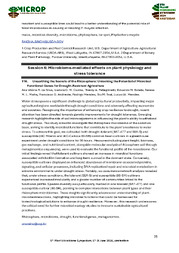Unearthing the secrets of the rhizosphere: unlocking the potential of microbial functional genes for drought-resistant agriculture.
Unearthing the secrets of the rhizosphere: unlocking the potential of microbial functional genes for drought-resistant agriculture.
Author(s): SILVA, A. V. R. da; CUNHA, I. C.; PELLEGRINETTI, T. A.; BOLETA, E. H. M.; MAFRA, T. M. L.; ANDREOTE, F. D.; MENDES, R.; TSAI, S.; MENDES, L. W.
Summary: Water stress poses a significant challenge to global agricultural productivity, impacting major agricultural regions worldwide throughdrought conditions and adversely affecting economies and societies. Recognizing the importance of enhancing crop resilience to drought, recentattention has been directed towards genetic improvements for drought tolerance. Emerging research highlights the role of soil microorganisms ininfluencing the plant’s ability to withstand drought stress. This study aimed to investigate the rhizosphere microbiome of the common bean,aiming to identify microbial functions that contribute to the plant’s resilience to water stress. To achieve this goal, we cultivated both drought-tolerant (BAT-477 and SEA-5) and susceptible (IAC Milenio and IAC-Carioca 80-SH) common bean cultivars in a greenhouse experiment underdrought conditions for 96 hours. Measures including plant height, biomass, gas exchange, and nutritional content, alongside molecular analysisof rhizosphere soil through metagenomics sequencing, were used to evaluate the functional profile of the microbiome. Our initial findings revealthat tolerant cultivars showed an increase in microbial functions associated with biofilm formation and long-term survival in the dormant state.Conversely, susceptible cultivars displayed an enhanced abundance of membrane-associated proteins, signaling, and cellular processes, includingDNA replication/repair and microbial metabolism in extreme environments under drought stress. Notably, co-occurrence network analysisrevealed that, under stress conditions, the tolerant (SEA-5) and susceptible (80-SH) cultivars experienced increased modularity and a greaternumber of communities linked to the functional profile. Species diversity was particularly marked in one tolerant (BAT-477) and one susceptiblecultivar (80-SH), pointing to complex interactions between plant types and their rhizosphere microbiomes. These insights significantly advanceour understanding of plantmicrobe interactions, highlighting microbial functions that could be harnessed for biotechnological solutions toenhance drought resilience. Moreover, this research underscores the critical need for further microbial ecology studies to innovate sustainableagricultural practices.
Publication year: 2024
Types of publication: Abstract in annals or event proceedings
Unit: Embrapa Environment
Keywords: Drought, Functional genes, Metagenomics, Microbiome, Rhizosphere, Rizosfera
Observation
Some of Embrapa's publications are published as ePub files. To read them, use or download one of the following free software options to your computer or mobile device. Android: Google Play Books; IOS: iBooks; Windows and Linux: Calibre.
Access other publications
Access the Agricultural Research Database (BDPA) to consult Embrapa's full library collection and records.
Visit Embrapa Bookstore to purchase books and other publications sold by Embrapa.

